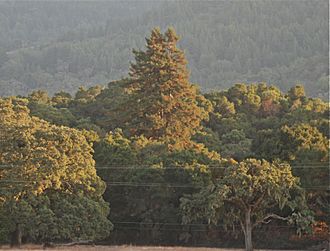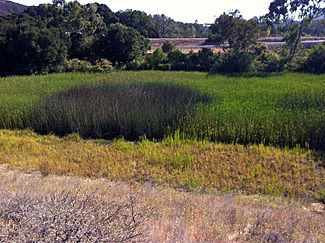Laguna Creek (San Mateo County) facts for kids
Quick facts for kids Laguna Creek |
|
|---|---|

Laguna Creek has perennial pools as shown here looking upstream from South Bridge at Filoli, mid-August 2012.
|
|
| Other name(s) | Lake Creek Cañada Raimundo Creek |
| Country | United States |
| State | California |
| Region | San Francisco Peninsula |
| County | San Mateo County |
| Physical characteristics | |
| Main source | Edgewood County Park 630 ft (190 m) 37°27′48″N 122°17′10″W / 37.46333°N 122.28611°W |
| River mouth | Confluence with Upper Crystal Springs Reservoir (but historically with San Mateo Creek) 285 ft (87 m) 37°28′57″N 122°19′19″W / 37.48250°N 122.32194°W |
| Basin features | |
| Tributaries |
|
Laguna Creek is a stream in San Mateo County, California. Its name means "Lake Creek" in Spanish. This creek flows about 2.6 miles (4.2 km) through Woodside, California. It runs along the famous San Andreas Fault.
The creek passes through the Phleger Estate and Filoli. It then flows into the Upper Crystal Springs Reservoir. Historically, Laguna Creek was a branch of San Mateo Creek. Eventually, its waters reach San Francisco Bay.
Contents
History of Laguna Creek
Early Explorers and Names
In 1769, the Portolá expedition discovered San Francisco Bay. They traveled along a creek now called San Andreas Creek. This led them to San Mateo Creek.
Just downstream from this spot, Laguna Creek joined San Mateo Creek. The explorers then followed Laguna Creek south. They camped by a large lake. Portolà named this lake Laguna Grande, meaning "Big Lake".
Today, the Upper Crystal Springs Reservoir covers this historic lake. A special marker, California Historical Marker No. 94, shows where Portolà's group camped. This marker is near the Crystal Springs Dam.
The names Laguna Creek and Laguna Grande appeared on old maps from the 1850s and 1860s. These maps were for areas like Rancho de las Pulgas and Rancho Cañada de Raymundo.
Raimundo and the Creek's Names
In 1797, a man named Raimundo was sent by Mission Santa Clara. He was from Baja California. His job was to find Mission Indians who had run away.
In 1840, Raimundo was given land called the Rancho Cañada de Raymundo. Because of him, the valley of Laguna Creek was sometimes called Cañada de Raymundo. The lake, Laguna Grande, also became known as Lake Raymundo. Laguna Creek itself was sometimes called Cañada Raimundo Creek.
The Spring Valley Water Company
The two Crystal Springs lakes and San Andreas Lake were once called the Spring Valley Lakes. This name came from the Spring Valley Water Company. This company owned the lakes.
The company started in San Francisco. When they needed more water, they expanded south. They brought the "Spring Valley" name with them.
In 1877, the Spring Valley Water Company built an earthen dam. This dam created the Upper Crystal Springs Reservoir. It covered the old Laguna Grande lake. This was the first Crystal Springs Dam.
Later, in 1888, a concrete dam was built by Herman Schussler. This new dam blocked San Mateo Creek. It formed the Lower Crystal Springs Reservoir. The old earthen dam became a path between the two reservoirs. Today, Highway 92 crosses this path.
The Filoli estate belonged to William Bourn. He was a wealthy leader of the Spring Valley Water Company. Today, Filoli is a historic place. The people who work there now call Laguna Creek "Orchard Creek". They call its smaller branches on the estate Fault Creek and Spring Creek.
Laguna Creek's Path
Laguna Creek starts in Edgewood County Park. It begins on the Serpentine Trail. The creek flows gently downhill. It then goes into a tunnel under Interstate-280.
After the tunnel, it flows west. It crosses Edgewood Road. The creek then enters two small reservoirs. These reservoirs might have been built to store water for wildfires.
The south fork of Laguna Creek also starts in Edgewood Park. It flows along the Clarkia Trail. This fork passes under I-280. It then flows northwest along Cañada Road.
The south fork passes Homestead Pond. It then joins the West Fork Laguna Creek. Finally, the south fork meets the main Laguna Creek. This meeting point is northwest of Edgewood Road and Cañada Road.
On the Filoli property, Laguna Creek is joined by other small streams. These include Fault Creek and Spring Creek. The Hetch Hetchy Aqueduct also joins it. This is just before the creek enters Upper Crystal Springs Reservoir.
Laguna Creek used to be longer. It was about 4.4 miles (7.1 km) long. But in 1888, the Lower Crystal Springs Reservoir was formed. This reservoir covered the part of Laguna Creek that joined San Mateo Creek. Adobe Gulch is another stream that flows into Upper Crystal Springs Reservoir.
Life in the Creek and Watershed

Historians have noted large groups of redwood trees (Sequoia sempervirens) in the Laguna Creek area. There were once two sawmills near Filoli. These mills cut down redwood trees for lumber. This shows that many trees were harvested long ago.
Today, a large redwood tree still stands near Laguna Creek. You can find it between the lower Filoli parking lot and the main entrance.
Fog Drip and Unique Plants
Fog drip is important for plants in the upper parts of the creek's watershed. Fog drip happens when fog collects on tree leaves. It then drips to the ground like rain.
Studies have shown that trees like tanoak (Lithocarpus densiflorus), coast redwood, and Douglas fir can collect a lot of fog drip. This extra moisture helps certain plants grow. For example, rare orchids like the giant helleborine (Epipactis gigantea) and phantom orchid (Cephalanthera austiniae) thrive in these moist areas.
Animals and Conservation
Both the main Laguna Creek and its south fork start in Edgewood County Park and Nature Preserve. This park has special grasslands. These grasslands are very important for the threatened Bay checkerspot butterfly (Euphydryas editha bayensis). Groups like the Friends of Edgewood Natural Preserve work to protect this habitat.
Near Cañada Road, there is a place called Homestead Pond. This pond and marsh are home to Western pond turtles (Actinemys marmorata). The San Francisco Public Utilities Commission is working to restore this area. They are removing non-native trees and planting native oaks and grasses.
Even though Laguna Creek often dries up in summer, it can still support fish. In 2012, young rainbow trout (Oncorhynchus mykiss) were seen in cold pools on the Filoli property. This was surprising because it was a very dry year. This shows that some parts of the creek stay wet and cold enough for fish to survive.


